Institutional subscribers can access this issue by clicking here. The issue is available for purchase in print and digital (PDF) format. To subscribe to WAJ, click here.
The “womanist” perspective sought affirmation and empowerment as powerful acts of resistance, contended the great poet and writer Alice Walker, which would not only bind diverse groups and bodies but encourage self-definition. The five articles assembled by the editors for the Spring/Summer Woman’s Art Journal diligently hone these lessons, spurring new dialogues, meanings, and interventions in the artistic lives of historical and contemporary Black women and lesbian/queer feminists.
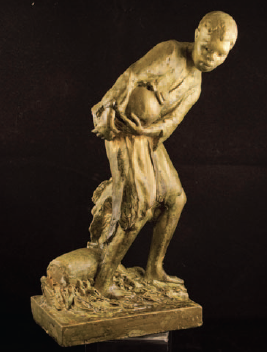
Setting this volume’s tone and chronological breadth is our cover by Meta Vaux Warrick Fuller called ethiopia awakening (1921), a heroic maquette of an African queen having emerged from her mummy-like wrapping (recently on view at the Metropolitan Museum’s stunning exhibition, the Harlem renaissance and transatlantic modernism). Trained in Philadelphia and Paris at the turn of the twentieth century, Fuller, an African American woman, produced sculptures in wax, plaster, and bronze dedicated to Sojourner Truth, Frederick Douglass, among other important figures in American history. Her 1913 emancipation monument, cast in bronze and installed in Boston long after her death, features two Black Americans, male and female, materializing from a tree, the “hand of fate” urging them forward into the future. For her study, Rachel Passannante has carefully documented and examined Fuller’s remarkable scrapbook of ephemera (newspaper clippings, photographs, and notes) that reveal the artist’s singular agency and identity amongst the creation of her “living” archive.
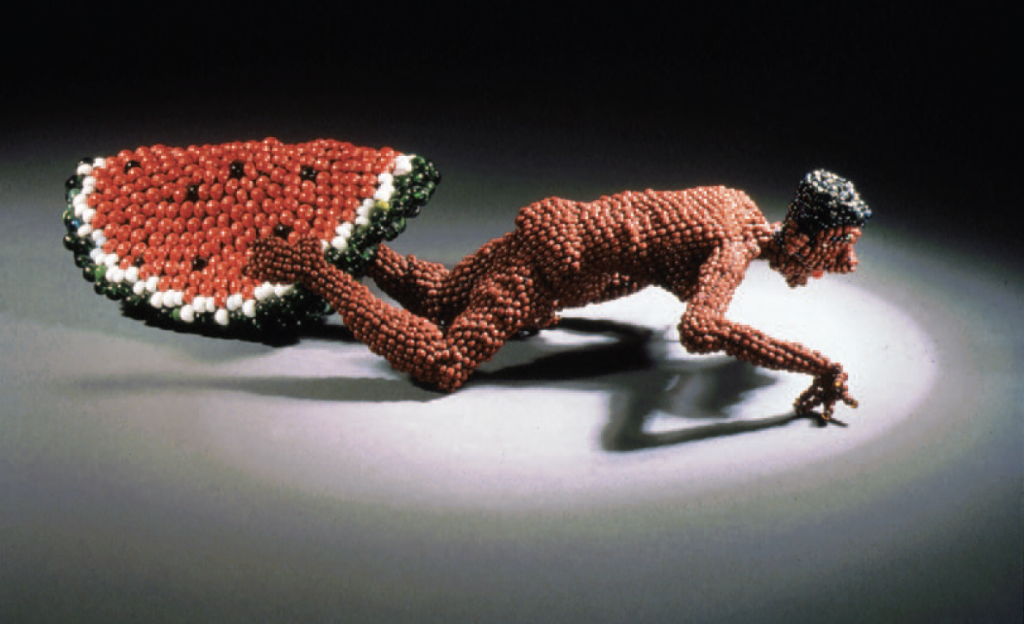
Man Eating Watermelon (1986), beads and thread, 2” x 8” x 3”. Collection Edward and Ursula McCracken, Baltimore, Maryland. Image courtesy of Goya Contemporary Gallery, Baltimore, Maryland.
A MacArthur Fellow, Joyce J. Scott plays in cunning ways with satire and humor, a perspective probed by Phoebe Wolfskill. Scott’s use of assemblage, beadwork, and wire (craft techniques learned from her family and Nigerian Yoruba weavings) also alludes to various contemporary “heroes” of Black fame, such as Aunt Jemima, and her confrontation of other racist stereotypes exploited through figurative distortions and ruptured bodies. By combining the comical and the brutal, Scott proves that humor can be deployed as a societal self-critique to alleviate the stresses on Black humanity.
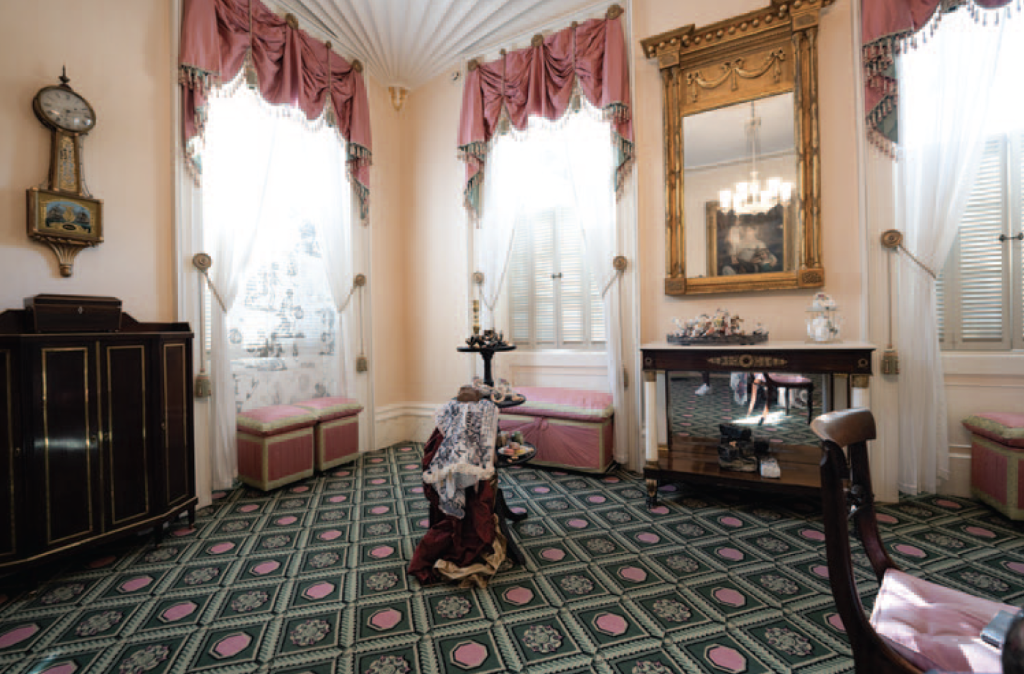
Look/See (2023), installation view of the Drawing Room at the Owens-Thomas House & Slave Quarters, Savannah, GA. Photo: Sharon Norwood.
In her review of Sharon Norwood’s startling installation at the Owens-Thomas House & Slave Quarters in Savannah, GA, Margaret Betz describes the artist’s recuperation of Black bodies from the presumed centers of “Southern hospitality.” The coiled impressions of the laboring and the enslaved haunt a drawing room for tea, where, amongst the fine china and carefully chosen objects, covered in hair, exists a forceful critique on the presence and treatment of Black servants who have performed duties for privileged white guests.
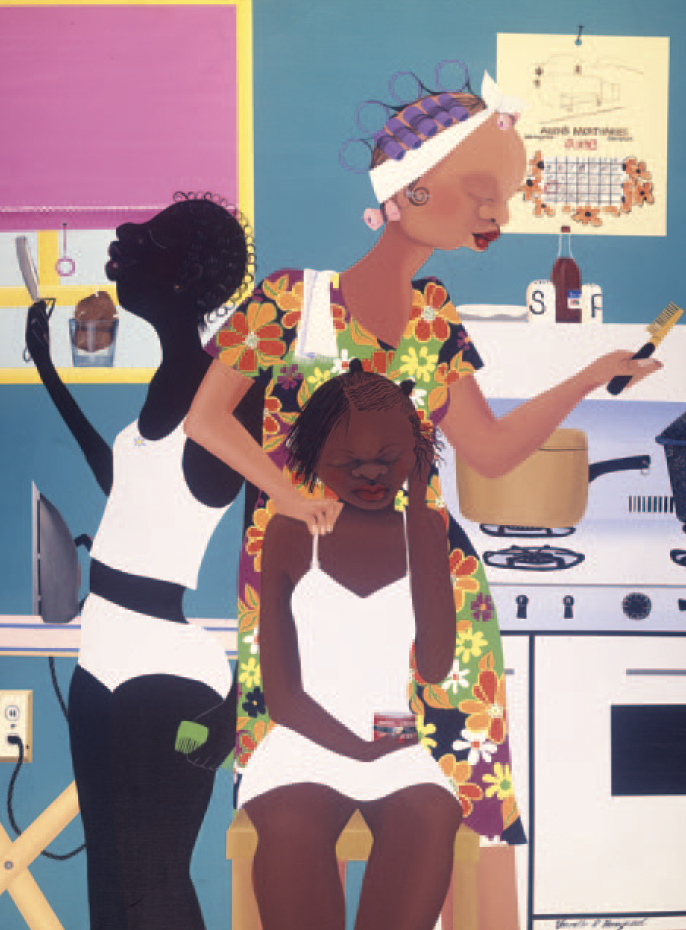
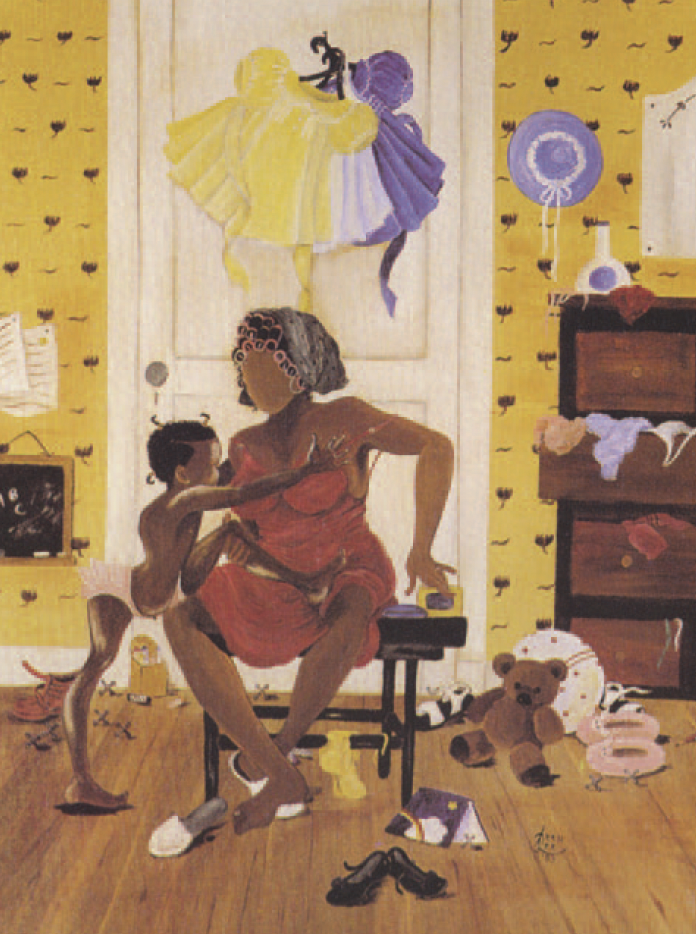
Author crystal am nelson explores the Black maternal in art works by Varnette P. Honeywood and Annie F. Lee, focusing on the transgenerational relationships between Black mothers and daughters shared in the domestic rituals of caregiving and the cultivation of Black beauty and community. Resisting the racist labeling of Black motherhood as spaces of crisis, and applying the fascinating ideas of womanism, nelson offers how their works elevate Black subjects as nurturing sites for safety and freedom.
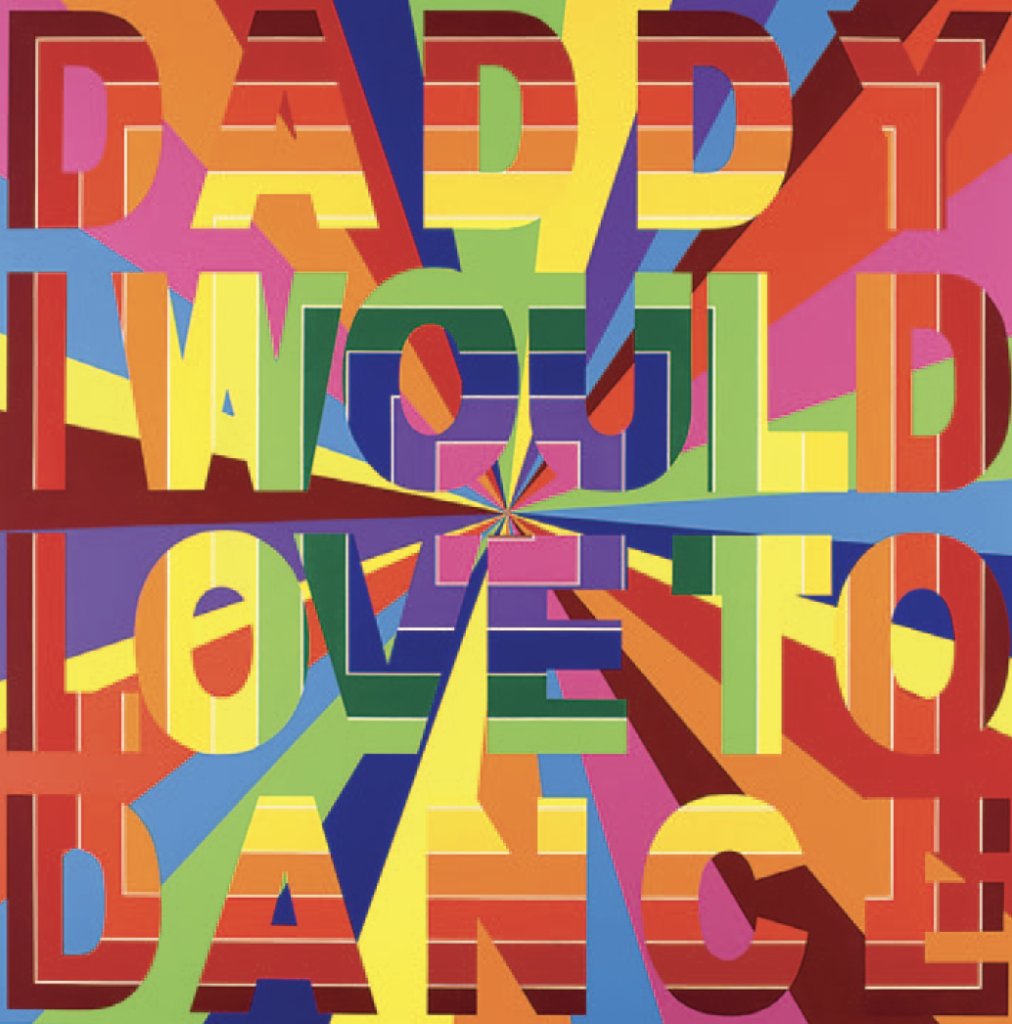
Daddy I Would Love to Dance (2008), acrylic on canvas,
78” x 78”. © Deborah Kass / Artist Rights Society (ARS), New York.
In Deborah Kass’s desire to talk, to dance, and to participate in history, she likewise stages her own form of lesbian intervention and sexual liberation through the critical legacies of postwar modern painting. Analyzing the operations of postmodernist allegory in Kass’s Feel Good Paintings for Feel Good times, Theo.
Triandos considers how this series exposes queer art history’s discursive failures and lesbian erasures; in the process, Kass “participates” in queer art history by interrogating its meaning, formulating feminist critiques and differences within queer, and expanding this history to include women and people of color who remain underrepresented in this critical space.
For this issue, book reviews editor Alison Poe has carefully curated a selection of monographs, many museum surveys, highlighting the biographical and personal character assessments on global artists. Jennifer S. Griffiths’s review reimagines feminist histories for the new millennium by engaging various temporal, anachronistic, archival, and queer strategies to enact a sense of belonging and community across time. In her discussion of Sonya Clark’s mid-career survey catalogue published by the Museum of Arts and Design (MAD), crystal am nelson expounds on the artist’s spirit of community and collaboration embedded in Clark’s craft-based practice, one organized around Black hair, its labor and styling representative of the African Diaspora that fosters global dialogue around topics of race and slavery. Roni Feinstein examines the Whitney catalogue that accompanies the museum’s five-decade career retrospective of tour de force Native American artist, activist, and curator Jaune Quick-to-See Smith, exploring her eclectic framing of art historical and American sources reworked within an Indigenous visual language. A Pulitzer Arts Foundation retrospective catalogue, contextualizing the erotically feminist motivations in the varied productions of Hannah Wilke, is detailed by Marissa Vigneault.
Helena Shaskevich, our inaugural online Interviews Editor, perceptively reviews the complexity of Shigeko Kubota’s life and oeuvre, and the metaphorically gendered deployment of the artist’s protean artistic language in video sculpture, her signature medium, as presented in two surveys from Japan (one co-organized by Midori Yoshimoto, WAJ’s editorial board member). Talia Kwartler takes an intimate biographical plunge into the avant-garde legacies of Surrealists Meret Oppenheim and Leonora Carrington—Meret explored in a magnificently documented autobiographical album, and Leonora, in a monograph, both formats recently translated into English, underscoring the importance of feminist interpretations in different geographical and temporal locales. Revisiting the masculine, mechanized language of Italian Futurism, Tara Kraft-Ainsworth’s review explores the feminist, maternally creative, and anti-Fascist contextualization of Marisa Mori’s postwar imagery. Christa Clarke’s close material studies of objects, race, and museological representations shed light on the remarkable history of African American “activist collector” Lida Clanton Broner and her journey from New Jersey to South Africa, as recounted by this volume’s reviewer, Henone Girma. Martha Skye Murphy takes aim at reigning in the wildly creative, metamorphic practice of avant-gardist Mina Loy, presented in a long overdue survey catalogue. In her review of French Impressionist Berthe Morisot, Julia Dabbs discusses how the artist’s unpopular turn to the past, found in the art and objects of the eighteenth-century in France and England, resulted, in fact, in her modernity and originality.
Joan Marter and Aliza Rachel Edelman
Editors, Woman’s Art Journal
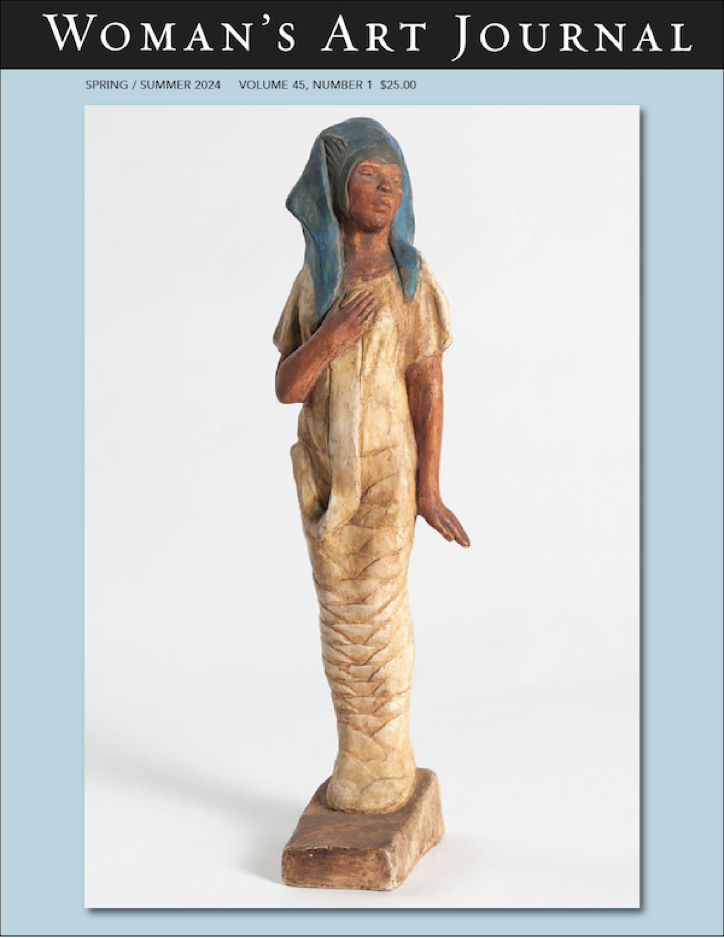
Parallel Perspectives
p. 2
By Joan Marter and Aliza Edelman
Portraits, Issues and Insights
p. 3
A Sculptor’s Legacy: Meta Vaux Warrick Fuller’s Scrapbook
By Rachel Passannante
p. 15
“Comedy, Pathos, Delight, and Horror”: Satire in the Work of Joyce J. Scott
By Phoebe Wolfskill
p. 26
Entangling Race, Gender, and Antebellum Savannah: Sharon Norwood’s Owens-Thomas House Intervention
By Margaret Bridget Betz
p. 31
Committed to Survival: The Womanist Visions of Varnette P. Honeywood and Annie F. Lee
By crystal am nelson
p. 39
Inside and Outside of “Queer”: Deborah Kass’s Feel Good Paintings for Feel Good Times
By Theo. Triandos
Reviews
p. 50
A Time of One’s Own: Histories of Feminism in Contemporary Art
By Catherine Grant
Reviewed by Jennifer S. Griffiths
p. 52
Sonya Clark: We Are Each Other
Edited by Elissa Auther, Laura Mott, and Monica Obniski
Reviewed by cystal am nelson
p. 55
Jaune Quick-to-See Smith: Memory Map
Edited by Laura Phipps
Reviewed by Roni Feinstein
p. 59
Hannah Wilke: Art for Life’s Sake
Edited by Tamara H. Schenkenberg and Donna Wingate
Reviewed by Marissa Vigneault
p. 61
Viva Video!: The Art and Life of Shigeko Kubota
Edited by Mayumi Hamada, Azusa Hashimoto, Mihoko Nishikawa, Midori Yoshimoto, and Yui Yoshizumi
Shigeko Kubota: Liquid Reality
Edited by Erica Papernik-Shimizu
Reviewed by Helena Shaskevich
p. 64
Marisa Mori and the Futurists: A Woman Artist in an Age of Fascism
By Jennifer S. Griffiths
Reviewed by Tara Kraft-Ainsworth
p. 67
Meret Oppenheim: My Album
By Meret Oppenheim. Edited by Lisa Wenger and Martina Corgnati
Leonora Carrington: The Image of Dreams
By Giulia Ingarao
Reviewed by Talia Kwartler
p. 70
The Activist Collector: Lida Clanton Broner’s 1938 Journey from Newark to South Africa
By Christa Clarke
Reviewed by Henone Girma
p. 72
Mina Loy: Strangeness Is Inevitable
By Jennifer R. Gross
Reviewed by Martha Skye Murphy
p. 75
Berthe Morisot: Shaping Impressionism
Edited by Marianne Mathieu
Reviewed by Julia Dabbs
Color Plates